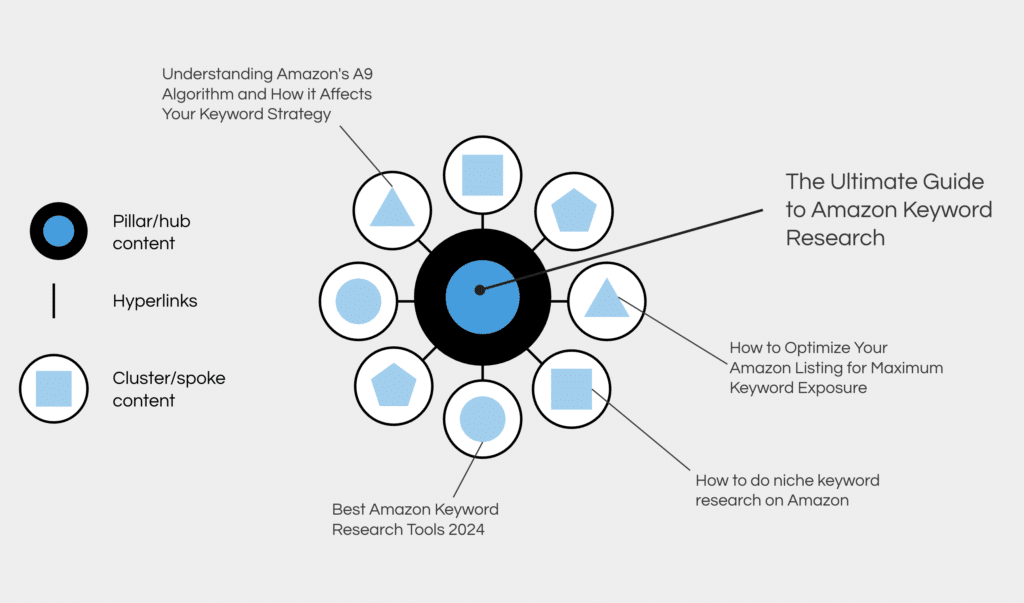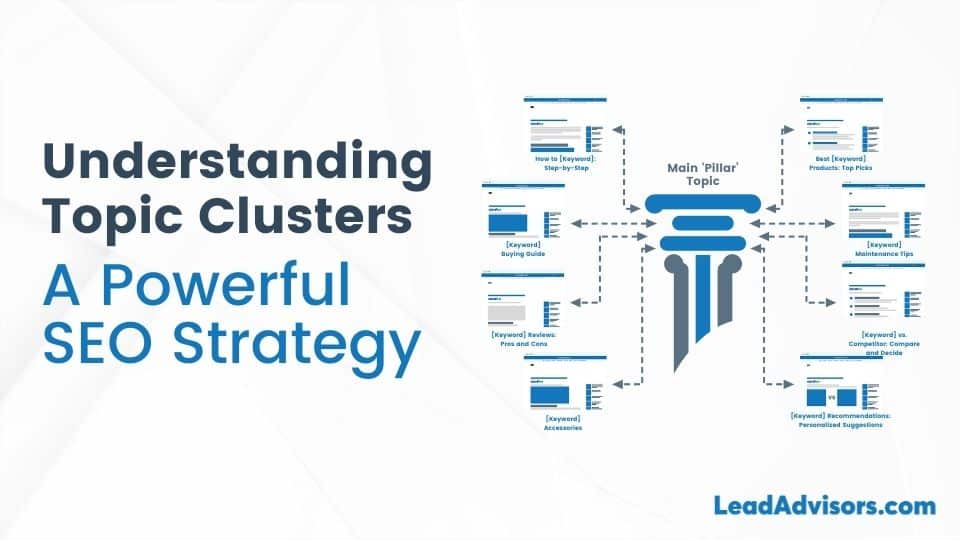Unlock the mystery of topic clusters and revolutionize your SEO strategy with this game-changing approach to content optimization.

Image courtesy of via DALL-E 3
Table of Contents
- Introduction: What Are Topic Clusters?
- Building Your First Topic Cluster
- Linking in Topic Clusters
- Finding Keywords for Your Topic Cluster
- Monitoring and Updating Your Topic Clusters
- Common Mistakes to Avoid
- Examples of Successful Topic Clusters
- Tools to Help You Create Topic Clusters
- FAQs About Topic Clusters
- Summary
Introduction: What Are Topic Clusters?
Have you ever wondered how Google or other search engines decide which websites to show you when you search for something online? That’s where SEO, which stands for Search Engine Optimization, comes into play. It helps websites like yours get noticed by search engines and appear higher in search results. One powerful SEO strategy that can help you boost your website’s visibility is using Topic Clusters.
Understanding SEO
SEO is like a magic tool that helps your website speak the same language as search engines. By using the right words and organizing your content in a smart way, you can make sure that search engines find your website and show it to people looking for information like yours. So, the better your SEO, the easier it is for people to find you online!
What is a Topic Cluster?
Now, let’s talk about Topic Clusters. Imagine your website is like a big puzzle, and each puzzle piece is a different piece of information or article. A Topic Cluster is like grouping puzzle pieces that fit together because they are all about the same main topic. This helps search engines understand your website better and makes it more likely for your content to show up in search results when people search for related topics.
Why Use Topic Clusters?
So, why should you care about Topic Clusters? Well, think of it as organizing your room. When everything is in its place and neatly arranged, it’s much easier to find what you need. The same goes for your website and its content. By using Topic Clusters, you can make it easier for search engines to understand what your website is about, improve user experience, and increase your chances of ranking higher in search results. It’s like a super easy way to help your website stand out!
Building Your First Topic Cluster
Creating a topic cluster may sound complicated, but it’s actually a straightforward process that can greatly benefit your website’s SEO. Let’s break it down into easy steps to help you build your first topic cluster from scratch.
Choosing Your Main Topic
When starting a topic cluster, the first step is to choose a broad topic that many people are interested in. Think of something that aligns with your website’s overall theme and is relevant to your target audience. This main topic will serve as the foundation for your cluster.
Creating Pillar Content
Once you’ve selected your main topic, it’s time to create pillar content. This piece should be comprehensive and detailed, covering all aspects of the main topic in depth. The pillar content acts as the central hub of your cluster, so make sure it’s well-researched and valuable to your readers.
Writing Supporting Content
Now that you have your pillar content in place, it’s essential to create supporting content that links back to the main topic. These smaller articles should cover specific subtopics or related ideas that connect back to the pillar content. By interlinking these articles, you strengthen the authority of your main topic in the eyes of search engines.
Linking in Topic Clusters
In order to make your topic clusters effective for SEO, it’s crucial to understand the significance of linking all pieces of content within the cluster. Internal linking plays a vital role in enhancing the user experience, improving website navigation, and boosting your search engine rankings.

Image courtesy of www.keywordinsights.ai via Google Images
Internal Links Explained
Internal links are like pathways that connect different pages of your website. They allow users to easily navigate through related content and help search engine crawlers discover and index your pages more efficiently. By linking your supporting content to the pillar content within a topic cluster, you create a network of interconnected pages that signal to search engines the relevance and authority of your content.
How to Link Your Content
When creating a topic cluster, be intentional about linking your supporting articles back to the pillar content. You can do this by including hyperlinks within your text that point back to the main topic. Make sure the anchor text (the clickable text in a hyperlink) is descriptive and relevant to the linked content. This not only helps users navigate your site but also reinforces the topical relevance of your cluster to search engines.
Finding Keywords for Your Topic Cluster
Keywords play a crucial role in improving the visibility of your content on search engines. By strategically incorporating relevant keywords into your topic cluster, you can attract more readers and improve your SEO rankings. Let’s dive into the world of keyword research and discover how you can find the best keywords for your topic cluster.
What Are Keywords?
Keywords are specific words or phrases that people type into search engines when looking for information. These keywords help search engines understand what your content is about and determine where to rank it in search results. By identifying and using the right keywords in your topic cluster, you can increase the chances of your content being discovered by your target audience.
Using Keyword Research Tools
There are various tools available that can assist you in finding the most relevant keywords for your topic cluster. Tools like Google Keyword Planner, SEMrush, and Ahrefs can help you identify popular keywords related to your main topic. These tools provide valuable insights into search volume, competition, and potential traffic, enabling you to make informed decisions about which keywords to target.
Tips for Choosing Keywords
When selecting keywords for your topic cluster, consider the following tips:
- Focus on long-tail keywords: Long-tail keywords are more specific and less competitive, making it easier for your content to rank higher in search results.
- Think like your audience: Put yourself in the shoes of your target audience and consider what words or phrases they would use to search for information related to your topic.
- Use a mix of broad and niche keywords: Incorporate a combination of broader keywords to attract a wider audience and niche keywords to target more specific segments.
By following these tips and utilizing keyword research tools, you can effectively optimize your topic cluster with the right keywords to enhance its visibility and reach.
Monitoring and Updating Your Topic Clusters
In the world of SEO, it’s not just about creating great content. It’s also crucial to monitor how your content is performing and ensure that it stays up to date. Let’s delve into the importance of watching your topic clusters and keeping them fresh.

Image courtesy of leadadvisors.com via Google Images
Why Monitoring Matters
Monitoring your topic clusters is like keeping an eye on your garden to see how your plants are growing. By checking how your content is doing in search results, you can identify what’s working well and what needs improvement. This way, you can make informed decisions on how to optimize your content for better visibility and engagement.
Tools for Monitoring
There are handy tools available that can help you track the performance of your topic clusters. Tools like Google Analytics and SEMrush can provide valuable insights into how your content is ranking, which keywords are driving traffic, and how visitors interact with your site. By utilizing these tools, you can gain a better understanding of your audience and tailor your content strategy accordingly.
How to Update Content
Just like how you water your plants to keep them healthy, updating your content is essential to maintain its relevance and effectiveness. To keep your topic clusters fresh, you can add new information, update statistics, refresh images, or even repurpose old content into something new. By regularly updating your content, you not only stay ahead of the competition but also provide value to your readers.
Common Mistakes to Avoid
One common mistake many people make when creating topic clusters is ignoring proper keyword research. Keywords are like the secret codes that help search engines understand what your content is about. If you overlook this step, your content may not reach the right audience.
Not Linking Properly
Another crucial mistake to avoid is not linking your content properly within the topic clusters. Internal linking is like creating a roadmap for both search engines and users to navigate through your content seamlessly. If you fail to link your articles correctly, it could affect your SEO performance.
Neglecting Updates
Neglecting to update your content regularly is a significant pitfall that can hinder your SEO efforts. Search engines favor fresh and up-to-date content, so failing to keep your topic clusters current can lead to a drop in search rankings. Make sure to revisit and refresh your content periodically to maintain its relevance.
Examples of Successful Topic Clusters
Imagine a popular cooking blog that covers a wide range of recipes and kitchen tips. By using topic clusters, this blog can group related content, such as “Healthy Recipes,” “Quick Meals,” and “Baking Techniques.” By creating pillar content around these topics and linking to supporting articles like “10 Easy Weeknight Dinner Recipes” or “Guide to Perfecting Your Bread Dough,” the cooking blog can attract more visitors interested in particular aspects of cooking. This strategy helps the blog rank higher on search engines for relevant keywords and keeps readers engaged with a variety of content.

Image courtesy of www.linkedin.com via Google Images
Example 2: A Science Website
A science website dedicated to popularizing scientific topics can benefit greatly from topic clusters. By organizing content into clusters like “Space Exploration,” “Climate Change,” and “Genetics,” the website can provide in-depth information on each subject. The pillar content for each cluster can delve deep into the main topic, while supporting articles can cover specific aspects like “The Impact of Global Warming on Polar Ice Caps” or “History of Space Exploration Missions.” This structure helps the website rank better for science-related keywords and increases user engagement with comprehensive content.
Example 3: A Travel Blog
For a travel blog that showcases various destinations and travel tips, topic clusters can be a game-changer. By grouping content into clusters like “Travel Guides,” “Budget Travel Tips,” and “Hotel Reviews,” the blog can target different interests of its audience. The pillar content for each cluster can offer detailed guides or tips, while supporting articles can highlight specific locations or travel hacks. This approach not only helps the travel blog rank higher in search results for travel-related keywords but also keeps readers coming back for more relevant and useful information.
Tools to Help You Create Topic Clusters
Creating topic clusters can be made easier and more efficient with the help of various tools designed to streamline the process. These tools can assist in organizing your content, identifying relevant keywords, and establishing internal links within your cluster. Here are some essential tools to consider:
Content Planning Tools
Content planning tools are crucial for organizing your topic clusters effectively. These tools help you map out your pillar content and supporting articles, ensuring a coherent structure that improves user experience and boosts SEO. Popular content planning tools include Trello, Asana, and HubSpot’s Content Strategy tool. These platforms allow you to visualize your content strategy, set deadlines, and collaborate with team members seamlessly.
Keyword Research Tools
Keyword research tools play a vital role in identifying the best keywords to target within your topic clusters. Tools like SEMrush, Moz Keyword Explorer, and Google Keyword Planner provide valuable insights into search volume, competition level, and related keywords. By leveraging these tools, you can optimize your content for relevant keywords that align with your target audience’s search intent, increasing the chances of ranking higher in search engine results.
Linking Tools
Establishing internal links between your pillar content and supporting articles is essential for enhancing user navigation and SEO performance. Linking tools such as Yoast SEO, Link Whisper, and Ahrefs help you create a well-connected cluster by suggesting relevant internal links and monitoring link health across your website. These tools automate the linking process, saving you time and ensuring a cohesive content structure that search engines favor.
FAQs About Topic Clusters
If you find that your chosen topic is too broad, don’t panic! You can break it down into more specific subtopics that still relate to the main theme. By creating more focused content around these smaller topics, you can then interlink them back to your pillar content, making them part of your topic cluster.

Image courtesy of ahrefs.com via Google Images
How Often Should I Update My Content?
Updating your content regularly is crucial to keep it fresh and relevant for your audience. The frequency of updates can vary depending on the topic and industry you’re in, but a good rule of thumb is to review and refresh your content at least every few months. This can involve adding new information, statistics, or examples to keep your content up-to-date and engaging.
Can I Use Topic Clusters on Any Website?
Yes, absolutely! Topic clusters can be beneficial for any type of website, regardless of its size or industry. By grouping related content together and creating a clear internal linking structure, you can improve your website’s organization, user experience, and search engine visibility. Whether you run a personal blog, a business website, or an online store, implementing topic clusters can help you attract more visitors and boost your SEO efforts.
Want to turn these SEO insights into real results? Seorocket is an all-in-one AI SEO solution that uses the power of AI to analyze your competition and craft high-ranking content.
Seorocket offers a suite of powerful tools, including a Keyword Researcher to find the most profitable keywords, an AI Writer to generate unique and Google-friendly content, and an Automatic Publisher to schedule and publish your content directly to your website. Plus, you’ll get real-time performance tracking so you can see exactly what’s working and make adjustments as needed.
Stop just reading about SEO – take action with Seorocket and skyrocket your search rankings today. Sign up for a free trial and see the difference Seorocket can make for your website!
Summary
In this blog post, we explored the concept of topic clusters and how they can be a powerful SEO strategy for improving website ranking. By organizing related content into clusters, websites can enhance their visibility on search engines. Let’s recap the key points we covered:
Understanding SEO
SEO, or Search Engine Optimization, is crucial for websites to improve their visibility and rank higher in search engine results.
What is a Topic Cluster?
A topic cluster involves grouping related content around a central topic, with a comprehensive pillar content serving as the core.
Why Use Topic Clusters?
Topic clusters can help in organizing content effectively, boosting SEO by improving internal linking, and making it easier for users to navigate through the website.
Building Your First Topic Cluster
Begin by choosing a broad main topic, creating detailed pillar content, and complementing it with supporting articles that link back to the core piece.
Linking in Topic Clusters
Internal linking within a topic cluster is important for directing users to related content and improving overall SEO performance.
Finding Keywords for Your Topic Cluster
Performing keyword research is essential to identify the best keywords that match the intent of your content and attract the right audience.
Monitoring and Updating Your Topic Clusters
Regularly monitoring the performance of your topic clusters and updating the content to keep it fresh and relevant are crucial for long-term success.
Common Mistakes to Avoid
Avoiding mistakes such as neglecting keyword research, improper linking, and infrequent content updates can ensure the effectiveness of your topic clusters.
Examples of Successful Topic Clusters
Real-world examples from a cooking blog, science website, and travel blog demonstrate how effectively implemented topic clusters can lead to improved SEO and increased visibility.
Tools to Help You Create Topic Clusters
Various tools, including content planning tools, keyword research tools, and linking tools, can assist in building and managing successful topic clusters.
FAQs About Topic Clusters
Answers to common questions about topic clusters, such as dealing with broad topics, updating content frequency, and the universality of topic clusters on different websites, have been provided.
By implementing topic clusters and following the strategies discussed in this blog post, websites can benefit from improved SEO and easier ranking on search engines. It’s time to start organizing your content into topic clusters and watch your website’s visibility soar!







